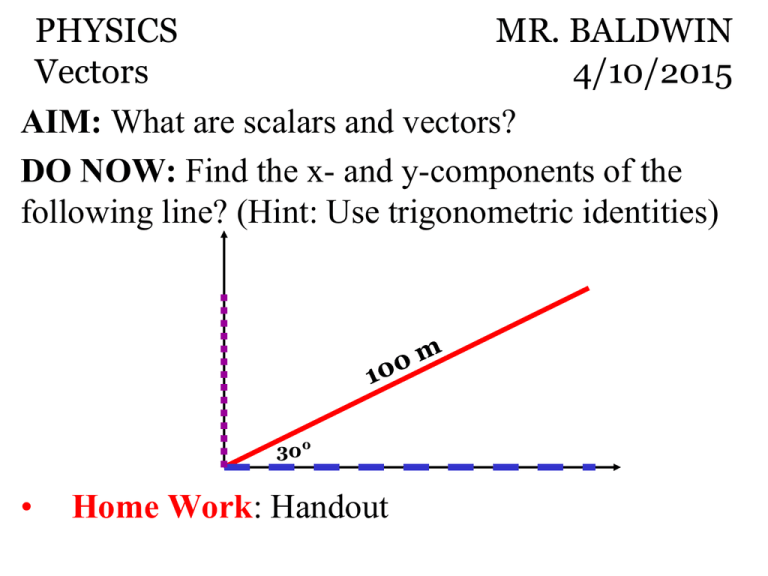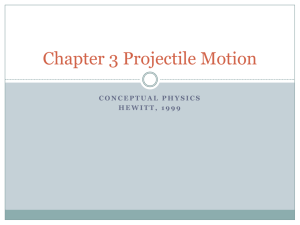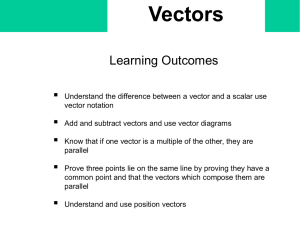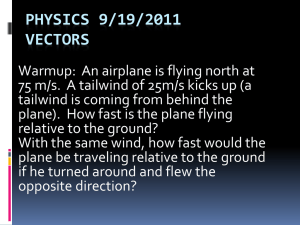Document
advertisement

PHYSICS MR. BALDWIN Vectors 4/10/2015 AIM: What are scalars and vectors? DO NOW: Find the x- and y-components of the following line? (Hint: Use trigonometric identities) 300 • Home Work: Handout Types of Quantities • The magnitude of a quantity tells how large the quantity is. • There are two types of quantities: – 1. Scalar quantities have magnitude only. – 2. Vector quantities have both magnitude and direction. CHECK. Can you give some examples of each? Scalars • • • • Mass Distance Speed Time • • • • Vectors Weight Displacement Velocity Acceleration Vectors - Which Way as Well as How Much • Velocity is a vector quantity that includes both speed and direction. • A vector is represented by an arrowhead line – Scaled – With direction Adding Vectors • To add scalar quantities, we simply use ordinary arithmetic. 5 kg of onions plus 3 kg of onions equals 8 kg of onions. • Vector quantities of the same kind whose directions are the same, we use the same arithmetic method. – If you north for 5 km and then drive north for 3 more km, you have traveled 8 km north. CHECK. • What if you drove 2 km South, then got out your car and ran south for 5 km and walked 3 more km south. How far are you from your starting point? • Draw a scaled representation of your journey. PHYSICS Vectors MR. BALDWIN 4/10/2015 AIM: How do we add 2D vectors? (How do we determine the resultant of vectors) DO NOW: Find the x- and y-components of the following vector? (Hint: Use trigonometric identities) 300 • Home Work: Handout Addition of Vectors: Resultant For vectors in same or opposite direction, simple addition or subtraction are all that is needed. You do need to be careful about the signs, as the figure indicates. Addition of Vectors in 2D • For vectors in two dimensions, we use the tailto-tip method. • The magnitude and direction of the resultant can be determined using trigonometric identities. Addition of Vectors:Graphical Methods The parallelogram method may also be used; here again the vectors must be “tail-to-tip.” Addition of Vectors: Graphical Methods Even if the vectors are not at right angles, they can be added graphically by using the “tail-to-tip” method. Trigonometric Identities sin opposite cos hypotenuse t an adjacent hypotenuse opposite adjacent Pythagoras Sine Rule : ' Theorem a sin A Cosine 2 : hyp opp b sin B 2 adj c sin C Rule : a b c 2 b c cos A 2 2 2 2 Vectors at 4.0 N 0o 5.0 N R= 9.0 N 5.0 N R= 3.6 N Vectors at 45o 4.0 N R= 6.4 N Vectors at 90o 4.0 N 5.0 N R= 8.3 N 5.0 N Vectors at 135o Vectors at 180o 4.0 N 4.0 N 5.0 N R= 1.0 N PHYSICS Vectors MR. BALDWIN 4/10/2015 AIM: How do we determine the resultant of vectors? DO NOW: (Quiz) Briefly explain, in words, how you would determine the resultant of vectors in 2 dimensions. Use the following vectors as your guide. NOW… Let’s HEAR some of your ideas. Recall: Addition of Vectors in 2D Even if the vectors are not at right angles, they can be added graphically by drawing vectors to scale and using the “tail-to-tip” method OR using trigonometry to solve. Components of Vectors If the components are perpendicular, they can be found using trigonometric functions. CHECK CHECK CHECK CHECK How far are you from your train? https://maps.google.com/maps?oe=UTF8&q=map+of+williamsburg+brooklyn&ie=U TF8&hq=&hnear=0x89c25bfd06c12a41:0x82 79f2291cc5d76c,Williamsburg,+Brooklyn,+ NY&gl=us&ei=LAxAUoDYBrj94APopIGgD Q&ved=0CCsQ8gEwAA VECTOR WALK You've just arrived in San Francisco to attend a physics teacher’s conference. You're staying at a hotel downtown, and you would like go to Carnelian Room for Sunday brunch. The hotel clerk gives you directions after you explain that you would like to go for nice long walk and end up at the Carnelian Room. On the way out you think it wise to double check yourself, so you ask 4 taxi cab drivers for directions. They are completely different. Now what do you do? Which cab driver gave you the best directions? Explain. LET’S GO PLAY • MAP your journey • http://phet.colorado.edu/sims/vectoraddition/vector-addition_en.html HW: Using your protractors, draw the following vectors to scale showing their x- and y-components. Then use trigonometry to verify your answer. 1. 5 cm @ 30O 2. 10 km @ 45O 3. 7 m @ 110O 4. 100 km/h @ 315O 5. 8 N @ 135O








